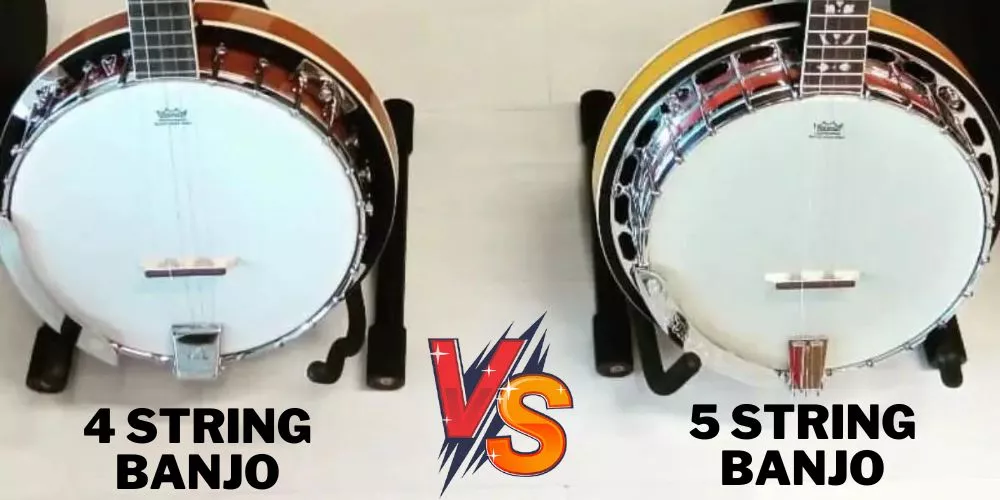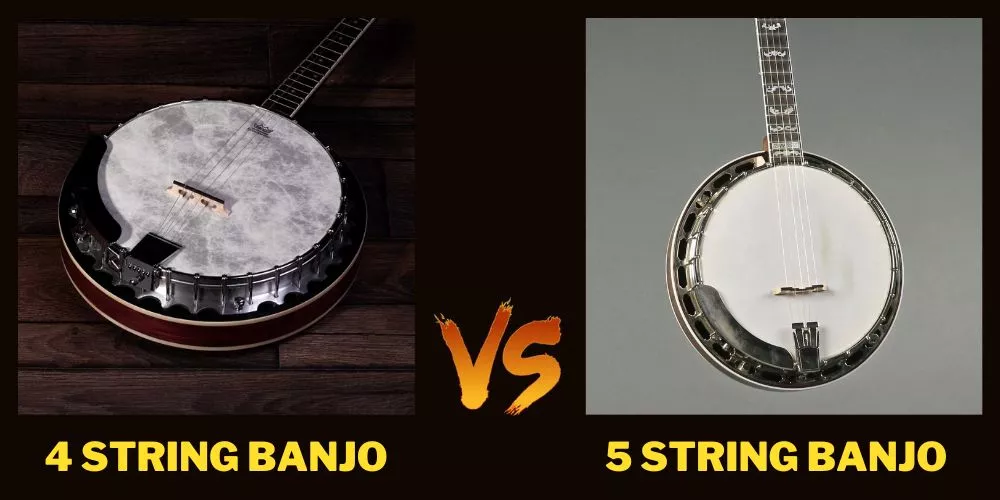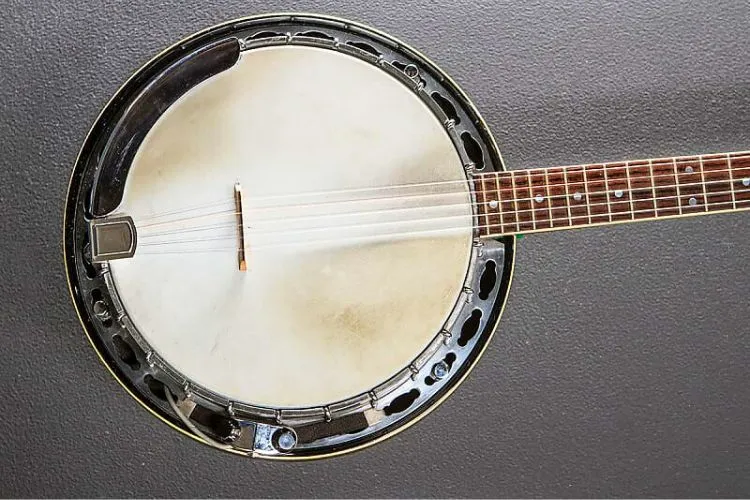In this article, we dive into an intriguing debate that every banjo player comes across at least once, the choice between 4 string vs 5 string banjo. As we delve into the details, we will shed light on the benefits, limitations, and intended purpose for each banjo type.

But, arguably the most significant difference between the two is the 5-string banjo’s additional shorter, thumb-played string, which brings its own unique flavour. Hold on tight as we pluck our way through the complex yet intriguing world of banjos!
Contents
🎶 4 string vs 5 string banjo
Banjos, the upbeat, twangy instruments that are synonymous with bluegrass and country music, come in various types. However, one conversation that keeps cropping up in music circles is the debate concerning 4-string and 5-string banjos.
So here, across the next 700 words, we’ll thoroughly compare these two types of banjos, from their physical traits and playability aspects to their sound profiles and genres of music they cater to.

Physical Differences
Firstly, let’s talk about the physical structure. As the names suggest, the most notable difference is the number of strings – 4 for tenor or plectrum banjos and 5 for bluegrass or folk banjos.
The 5-string banjo has an extra, shorter drone string known as the thumb string, starting at the fifth fret, giving it a different architecture in comparison to the 4-string banjo. The fretboard of the 4-string banjo is typically shorter too, resulting in closer string spacing, which can be a limiting factor for some players.
Playability
This brings us to the issue of playability. A 4-string banjo generally uses a pick and is strummed much like a guitar or mandolin, making it veritably easier for people transitioning from these instruments.
On the other hand, the 5-string banjo requires a more specialized finger-picking or “clawhammer” style that can be intimidating for beginners. The distinct fifth string introduces a unique layer of complexity to the playing technique, albeit one that can pay off splendidly in the hands of a proficient player.
Sound
On the sonic front, the 5-string banjo has a brighter, more “ringing” sound derived from its thumb string’s repeated drone effect. It’s this distinctly vibrant sound that’s closely associated with the bluegrass genre.
Conversely, the 4-string banjo provides a warmer, jazzier tone which is, attributed to its‘string-even’ design, allows chordal patterns and strumming to stand out prominently. Thus, these different sound profiles mean that each banjo variant speaks a unique musical dialect.
Musical Genres
Discussing the genres that these banjos cater to, the 4-string banjo was traditionally used in early Jazz and Ragtime music and even Irish Folk. The strumming style associated with it lends itself to these genres.
Likewise, the 5-string banjo’s unique droning sound makes it the signature instrument of the Bluegrass, Country, and American Folk music. Hence, your preferred music genre may indeed influence what kind of banjo you gravitate towards.
Set-Up and Tuning
Furthermore, the setup and tuning again show stark differences. The 4-string banjos are often tuned in a linear, or ‘plectrum,’ tuning (akin to a violin or mandolin) or ‘jazz’ tuning (similar to the first four strings of a guitar).
The 5-string banjo, in contrast, has a unique open-G tuning where the strings, when strummed open, produce a G-major chord. This open-string tuning significantly influences the 5-string banjo’s sound and playing style.
Which One to Choose?
So, which is the right banjo for you? This depends on what you find more exciting – the jazzy, chordal music where 4-string banjos thrive or the bright, fast, and complex solos typical for 5-string bluegrass banjos. For starting musicians, the choice may come down to familiarity and comfort, as the 4-string banjo, due to its strumming style, can be more accessible for those transferring from a guitar or similar strings background.
In conclusion, both the 4-string and 5-string banjos have their unique musical territories with marked differences in physical structure, playability, sound, and genre applicability. But remember, irrespective of whether you’re strumming a 4-string or picking a 5-string, the ultimate goal is to enjoy the resonance of your music, and that, at the end of the day, is entirely in your hands.
🎶 A Beginner’s Perspective: 4-String Vs 5-String Banjo
Starting your musical journey with the banjo is an exciting venture. But here comes the first decision: should you opt for a 4-string or a 5-string banjo? Both are viable options and can be great instruments for beginners, but they do present different challenges and musical opportunities.
4-String Banjo
The 4-string banjo, also known as the tenor or plectrum banjo, is often considered the most accessible option for beginners, especially for those transitioning from other strummed instruments like guitar or ukulele. Here’s why:
- Similarity to Other Instruments: The 4-string banjo is typically played with a strumming style, which is similar to many stringed instruments. If you’ve ever played guitar or ukulele, this style will feel very familiar, making it an easier transition.
- Tuning and Playability: The 4-string banjo can be tuned similar to other string instruments. One method is the “Chicago tuning,” which matches the first four strings of a guitar. This familiarity in tuning and playability can help newcomers feel more comfortable when learning.
- Genre: The 4-string banjo is common in styles such as Jazz, Celtic and Irish traditional music. If these genres align with your musical tastes, a 4-string banjo might be the best choice for you.
5-String Banjo
On the other side of the equation, the 5-string banjo is a staple in the bluegrass, country, and folk genres. It’s a more specialized instrument, and while it might present a bit of a steeper learning curve for beginners, it offers some unique rewards:

- Distinctive Sound: The short, thumb-played fifth string gives the 5-string banjo its characteristic, drone-rich sound, which is particularly effective in bluegrass and country music. This offers a captivating, resonant sound if that’s what you’re aimed towards.
- Fingerpicking Techniques: The 5-string banjo is typically played using fingerpicking or clawhammer styles. These techniques can be more complex, but also incredibly satisfying once mastered.
- Open Tuning: 5-string banjos typically use an open G tuning, where the open strings form a G major chord. This allows strumming without fretting any strings, making playing easier for beginners once they adjust to it.
In conclusion, choosing between a 4-string or 5-string banjo as a beginner primarily depends on your personal musical preference and your comfort level with different playing techniques. If you’re seeking an easier transition from other string instruments and enjoy genres like Jazz or Celtic music, a 4-string banjo is a good choice.
Conversely, if you’re fascinated by the distinctive sound and fingerpicking technique usually linked to genres like bluegrass and country, investing your time in learning the 5-string banjo can be rewarding. Remember, choosing an instrument is very personal, and the best one for you is the one that fits your musical style and brings you joy to play.
🎶Frequently Asked Questions (FAQs)
Answer: Yes, technically, you can play a 5-string banjo like a 4-string model by ignoring or tuning the additional drone string and focusing only on the first four strings, similar to the tenor banjo configuration. However, this method doesn’t leverage the unique 5-string banjo characteristics or its rich resonant sound. You would also need to adjust your playing style to match the pick and strum technique usually associated with 4-string banjos.
Answer: The ease of playing a 4-string banjo depends largely on your musical background and familiarity with other stringed instruments. It’s often easier for individuals transitioning from guitar or ukulele due to its similar strumming techniques and chord structures. Furthermore, it has fewer strings, closer to that of a guitar, which some beginners might find less intimidating than the extra string on a 5-string banjo.
Answer: The “easiest” banjo for beginners largely depends on personal preferences and the style of music you want to play. The 4-string banjo, particularly one tuned in “Chicago style” (D,G,B,E – like the first four strings of a guitar), can be easier if you have experience with a guitar or similar stringed instrument. On the other hand, the 5-string banjo with its open G tuning provides a full banjo experience widely used in bluegrass and folk music, though it might require a bit more practice to master.
Other banjo comparison article you may find useful: Fiddle vs Banjo | Ukulele vs Banjo
Conclusion:
Both the 4-string and 5-string banjo have unique characteristics that cater to different musical styles and player preferences. The choice ultimately depends on your affinity towards certain genres, your background with string instruments, and your willingness to master specific playing techniques.
The 4-string banjo might offer an easier transition for guitarists, while the 5-string banjo provides a richer, distinctive sound associated with bluegrass and folk. Both paths offer musical enrichment, so choose the instrument that most resonates with your musical ambitions and enjoy your journey into the world of banjo playing.
